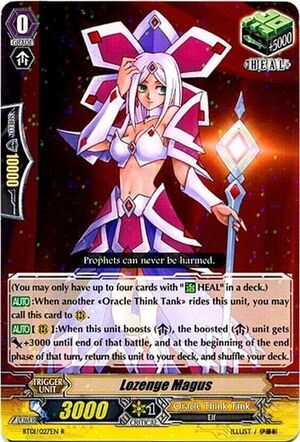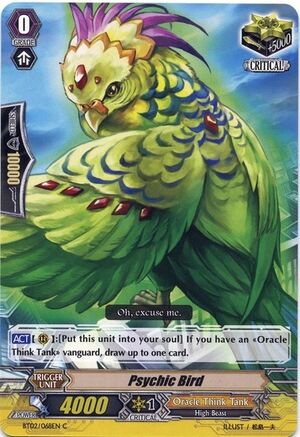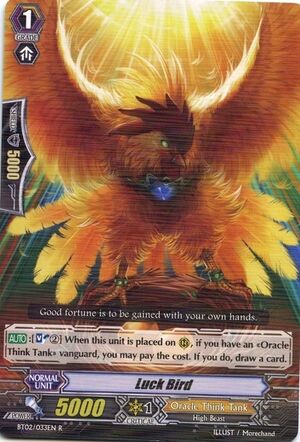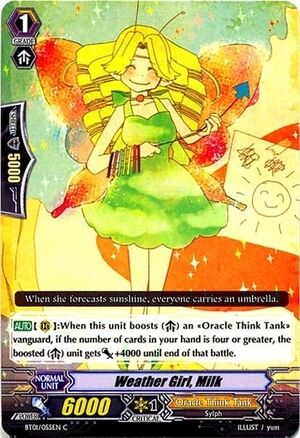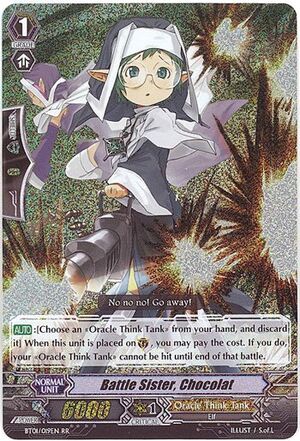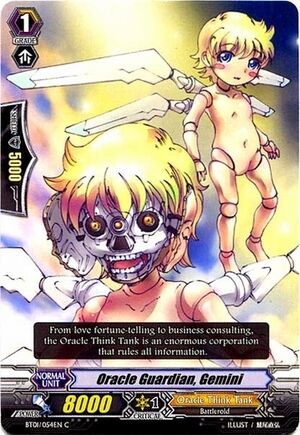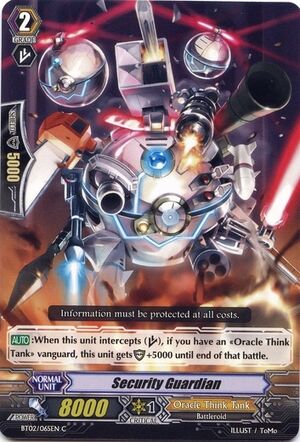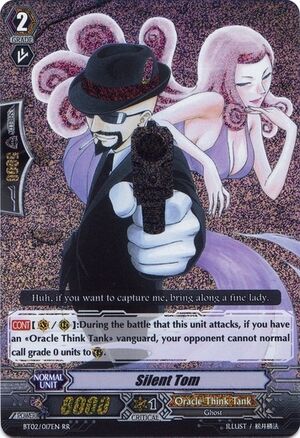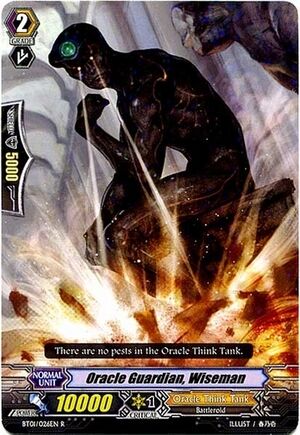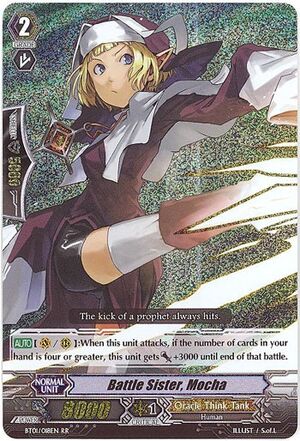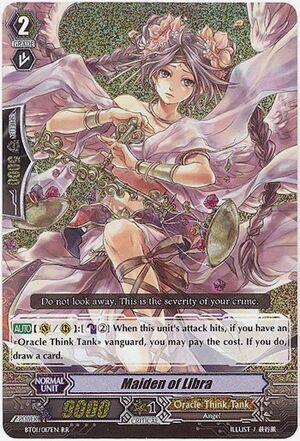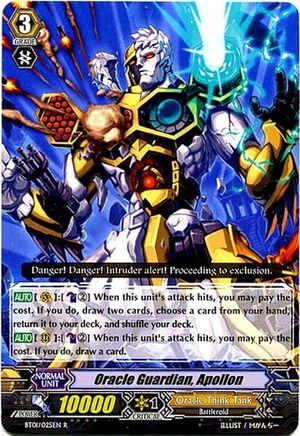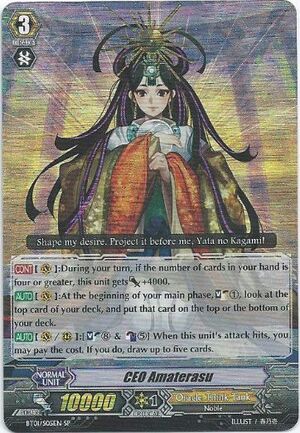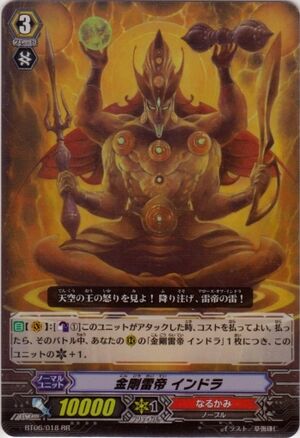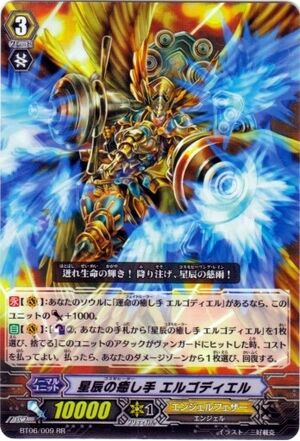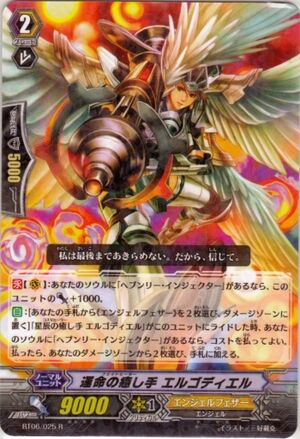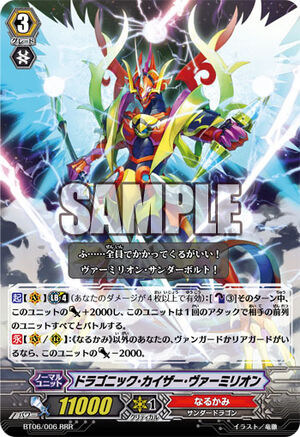In conjunction with a video that I made and will be up on the YouTube channel DifferenceinSkill, I will be making a blog post here and a thread on Pojo regarding the cards available to Oracle Think Tank and my brief opinion on them to act as a guide when you are creating your own deck. The purpose is not to tell you a cookie-cutter build or spoon-feed you, but through comparisons and logic simply guide you down the correct deck-building path rather than the path I have seen some people take. Moreover I will be talking about the playstyle behind the deck so people can see if this deck is suitable for them.
Playstyle
Oracle Think Tank is not a hard-hitting deck. It does not have the swarming power of Royal Paladin or the control aspect of Kagero. It cannot keep standing it's units to create advantage like Nova Grappler. Oracle Think Tank revolves around controlling your own deck. Through manipulating what the top card is on your deck, you plan your plays accordingly or you can also bluff your opponent. Oracle Think Tank creates advantage by "playing ahead" per se, that is by adapting your play to what will be coming up, giving you the edge compared to your opponent. Moreover, through effects that let you draw cards, hand advantage is created and through effects that let you see the top card of your deck, allows you to get cards that you need faster than your opponent, also giving you the field advantage when it comes to setting up your field. As such, some degree of understanding and thinking is required in and out of a match, therefore this deck may not be for everyone. If you enjoy playing a relatively passive deck while having the ability to control what your opponent thinks, then Oracle Think Tank is the deck for you.
Grade 0's/Triggers
As a starting Vanguard, only one possibility exists: the heal trigger Lozenge Magus. When you ride an Oracle Think Tank unit over it, it retreats to a rearguard circle of your choosing. When it boosts, it gains 3k power, allowing it to boost for a modest 6k. Once it's done boosting, it returns to the deck at the end of the turn, so you're able to reuse it's heal ability over and over again.
As for triggers, it all becomes preference. At the moment, Oracle Think Tank has 2 Draw Triggers, 2 Critical Triggers and 1 Heal Trigger (I won't even mention Stands as they are never run in Oracle Think Tank). 4 Heal triggers is a must, therefore the last 12 triggers are a personal choice between any number of criticals and draws. Some people go 8 crit, 4 draw while others, like myself, prefer the 6/6 option. Only through testing will you find a ratio that works for you and your specific playstyle. The only trigger that deserves a special mention is Psychic Bird, the second Oracle Think Tank critical trigger. Simply by calling it and adding it to the soul, you are allowed to draw a card, making getting that card you just saw with Battle Sister, Cocoa or CEO Amaterasu to your hand a lot easier.
Grade 1's
When it comes to Grade 1's, there isn't a lot of variety, but I'll still go through the options:
Luck Bird
Auto: [Soulblast (2)] When this unit is placed on R, if you have a
<<Oracle Think Tank>> Vanguard, you may pay the cost. If you do, draw a card.
A plus one sure, but it's 5k power makes it a poor booster. It's enough behind a 10k attacker, but if your opponent has an 11k Vanguard, it's next to useless. Only has good synergy with Battle Sister, Mocha which boosted with Luck Bird can hit for 16k with Mocha's ability. Run no more than 2.
Weather Girl, Milk
[AUTO](RC): When this unit boosts an <<Oracle Think Tank>> Vanguard, if the number of cards in your hand is four or greater, the boosted unit gets [Power] +4000 until end of that battle.
Beside boosting the Vanguard, 6k boost is subpar. You do not want to call it to boost a rearguard as it's effect is only if it boosts the Vanguard. Since you do want to keep your Gemini for your rearguards, running 2 to boost CEO to 24k and hit enough to force 15k-20k from an 11k Vanguard is helpful since
Oracle Think Tank currently has no 7k boosters. Run no more than 2.
Battle Sister, Cocoa
[AUTO]: When this unit is placed on (VC) or (RC), if you have an <<Oracle Think Tank>> Vanguard, look at the top card of your deck, and put that card on the top or the bottom of your deck.
Decent 6k boost allows for 10k beaters to hit 16k, and it's ability helps you set up your triggers or field the way you want it. Run 3-4.
Battle Sister, Chocolat
AUTO: [Choose a «Oracle Think Tank» from your hand, and discard it] When this unit is placed on Guardian Circle, you may pay the cost. If you do, choose one of your «Oracle Think Tank», and that unit cannot be hit until end of that battle.
The perfect guard for
Oracle Think Tank. Run 4, no questions asked. For explanation, refer to my previous article, The Perfect Guard Problem.
Oracle Guardian, Gemini
The 8k vanilla booster. Once again, run 4 no questions asked. Necessary to boost Silent Tom do a decent amount to make it's effect worthwhile.
Grade 2's
Once again, not too much variety. That all changes once Set 3 is released but for now here's what we got:
Security Guardian
[Auto]: When this Unit intercepts, and you have a 《Oracle Think Tank》 Vanguard, during that battle, this Unit's Shield gains +5000.
Superior intercept for
Oracle Think Tank. With an emphasis on draw triggers and a lower amount of 10k shields, it's not a bad card to run. Furthermore, if your opponent targets it for an attack, just let it die and it has taken an attack that otherwise would've gone to your Vanguard, acting as a 10k-15k shield just like that. Run no more than 2.
Silent Tom
[CONT] 【V/R】: During a battle when this Unit attacks, if you have a 《Oracle Think Tank》 Vanguard, your Opponent cannot normal call a Grade 0 to the Guardian Circle.
Extremely good card, but I see people misusing it all the time. Should never be placed in front of any booster that's not Gemini otherwise it will be attacking for pitiful amounts. Players should not be in a rush to play it and should wait until it's a good time to play it. Moreover, because of its necessity for Gemini, playing something permanent, such as a Grade 3 in front of a Gemini should be avoided. Try to always play a Grade 2 in front of a Gemini as it may intercept in order to free up the rearguard space for Silent Tom. Used properly, Silent Tom can win games easily. Run 3-4 but use it wisely. For more on Silent Tom, check out my video, Oracle Think Tank 101 Episode 1 on the YouTube channel DifferenceInSkill.
Oracle Guardian Wiseman
10k vanilla attacker. Currently, should be running 4 but once Set 3 comes out other cards become priority.
Battle Sister, Mocha
[AUTO](VC/RC): When this unit attacks, if the number of cards in your hand is four or greater, this unit gets [Power] +3000 until end of that battle.
After a Twin Drive, you should have no problem boosting Mocha to 11k. Can hit 11k Vanguards by herself, and as stated previously, has good synergy with the otherwise useless Luck Bird. Some people say you have to play "conservatively" in order to get it's effect off, but if you have less than two cards at the beginning of your turn then getting Mocha to 11k is the last of your worries. I recommend running at least 2, I personally run 3. 4 may be too many however, so just test it out as you wish.
Maiden of Libra
[AUTO](VC/RC): [Counter-Blast 2] When this unit's attack hits, if you have an <Oracle Think Tank> vanguard, you may pay the cost. If you do, draw a card.
I'm going to be blunt, I dislike this card. Oracle Guardian Apollon has the same effect with higher power. Not only will having this card targeted cost you shield, but it's 9k makes a Gemini behind it a necessity against 11k Vanguards, where with Apollon a 6k booster is enough. I believe Apollon is better in every aspect this card has to offer. Run 2 maximum, but I run 0.
Grade 3's
There are 2 Grade 3's, (excluding Scarlet Witch, CoCo) that can be run in a standard
Oracle Think Tank deck:
Oracle Guardian, Apollon
[AUTO](VC): [Counter-Blast 2] When this unit's attack hits, you may pay the cost. If you do, draw two cards, choose a card from your hand, return it to your deck, and shuffle your deck.
[AUTO](RC): [Counter-Blast 2] When this unit's attack hits, you may pay the cost. If you do, draw a card.
It's not CEO Amaterasu, but it's a decent rearguard. Similar to Maiden of Libra, but fits the role better. If it's targeted by an attack because your opponent doesn't want to deal with, you've lost no shields in the process and it took an attack away from your Vanguard. Depending on the amount of Grade 3's you wish to run, run 3-4.
CEO Amaterasu
[CONT](VC): During your turn, if the number of cards in your hand is four or greater, this unit gets [Power] +4000.
[AUTO](VC): At the beginning of your main phase, [Soul-Charge 1], look at the top card of your deck, and put that card on the top or the bottom of your deck.[AUTO](VC/RC): [Soul-Blast 8 & Counter-Blast 5] When this unit's attack hits, you may pay the cost. If you do, draw up to five cards.
Amazing card. Gains 4k power if you have 4 or more cards in hand, which includes during and after a Twin Drive, meaning you only need 2 cards in your hand when you attack for her to gain the power. This boosts her to 20k in front of a 6k booster and 22k in front of a Gemini. Her second effect allows you to look at the top card of your deck and decide if you want to put it at the bottom or keep it at the top. Once again, this allows in setting up your triggers and if it's a card you wish to have you can get it with one of the many drawing effects
Oracle Think Tank has. If you are lucky (or skilled) enough to get off it's Megablast you can draw up to 5 cards. Unfortunately, it has no benefits from being in the rearguard circles, so refrain from calling it there unless necessary. Keep extra CEO Amaterasus in your hand to ditch for your perfect guards.
Conclusion
I hope through this guide you have started to at least form a decklist in your mind. Remind yourself that
Oracle Think Tank has a very specific playstyle, which to be successful, needs to be mastered. Through enough practice with the deck, you will get hang of how the deck works soon enough, and I hope you truly appreciate how the deck is meant to function. Once Set 3 comes out, huge improvements are made (for details check out my articles here and here). For now, go out and have fun with it!
-HerO
Don't forget to check out KS Games for your Cardfight!! Vanguard needs!
